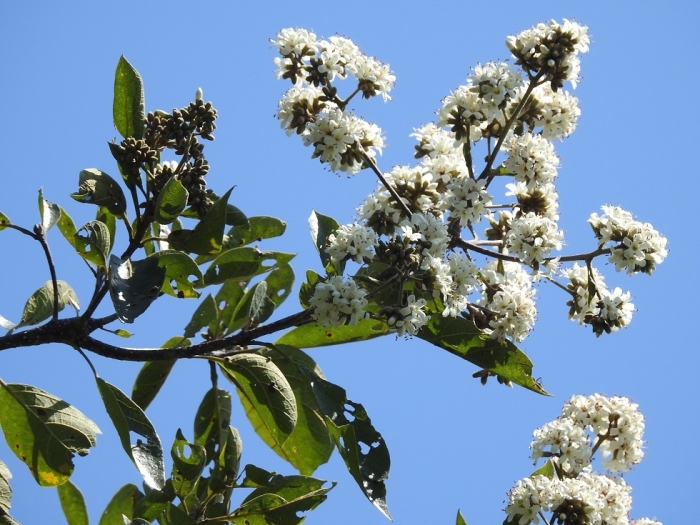Spanish Elm
(Cordia alliodora)
Spanish Elm (Cordia alliodora)
/
/

Neptalí Ramírez Marcial
CC BY 4.0
Image By:
Neptalí Ramírez Marcial
Recorded By:
Copyright:
CC BY 4.0
Copyright Notice:
Photo by: Neptalí Ramírez Marcial | License Type: CC BY 4.0 | License URL: http://creativecommons.org/licenses/by/4.0/ | Rights Holder: Neptalí Ramírez Marcial | Publisher: iNaturalist | Date Created: 2017-11-18T11:26:50-08:00 |

























Estimated Native Range
Summary
Cordia alliodora, commonly known as Spanish elm, Ecuador laurel or salmwood. It is a fast-growing, evergreen tree native to tropical rainforests from Mexico to South America, including the Caribbean. This species typically reaches up to 115 feet (35 meters) in height with a straight, cylindrical trunk and a dense, rounded crown. The leaves are large, leathery, and dark green, and the tree produces clusters of small, fragrant white flowers that are attractive to bees and butterflies. Flowering usually occurs during the dry season.
Ecuador laurel is valued for its lightweight, aromatic, and termite-resistant wood, making it popular for use in high-quality furniture, cabinetry, and musical instruments such as guitars. It is also used in reforestation projects and as a shade tree in coffee plantations due to its fast growth and beneficial interactions with crops. In cultivation, it requires full sun and well-drained soils but can tolerate a range of soil types. While it is drought-tolerant once established, it benefits from regular watering during prolonged dry periods. However, it is important to be cautious with its use outside its native range, as it has become invasive in some Pacific islands, such as Vanuatu, where it can outcompete native species and disrupt local ecosystems.CC BY-SA 4.0
Ecuador laurel is valued for its lightweight, aromatic, and termite-resistant wood, making it popular for use in high-quality furniture, cabinetry, and musical instruments such as guitars. It is also used in reforestation projects and as a shade tree in coffee plantations due to its fast growth and beneficial interactions with crops. In cultivation, it requires full sun and well-drained soils but can tolerate a range of soil types. While it is drought-tolerant once established, it benefits from regular watering during prolonged dry periods. However, it is important to be cautious with its use outside its native range, as it has become invasive in some Pacific islands, such as Vanuatu, where it can outcompete native species and disrupt local ecosystems.CC BY-SA 4.0
Plant Description
- Plant Type: Tree
- Height: 100-130 feet
- Width: 40-60 feet
- Growth Rate: Moderate, Rapid
- Flower Color: White
- Flowering Season: Spring
- Leaf Retention: Deciduous, Semi-deciduous
Growth Requirements
- Sun: Full Sun, Part Shade
- Water: High
- Drainage: Fast, Medium, Slow
Common Uses
Natural Habitat
Tropical rainforests from Mexico to South America, including the Caribbean
Other Names
Common Names: Cyp, Equador Laurel
Scientific Names: , Cordia alliodora, Cerdana alliodora, Cerdana complicata, Cerdana complicata, Cerdana cujabensis, Cerdana cujabensis, Cordia alliodora, Cordia alliodora f. albotomentosa, Cordia alliodora var. boliviana
GBIF Accepted Name: